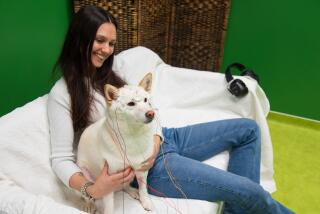Dogs learn to sit, stay, get brains scanned
You think your dog can sit and stay? You might want to check out the pooches in Budapest, Hungary, that managed to be still for eight-minute stretches in a brain scanner without twitching their tails or moving their bodies more than three millimeters.
The 11 border collies and golden retrievers, in fact, equaled or bested their 22 human cohorts in the first-ever comparison of functional magnetic resonance imagery between man and his best friend, said Attila Andics, a neuroscientist at Eotvos Lorand University in Budapest who led the research.
The study results, published Thursday in the journal Current Biology, suggests humans and canines share similar brain regions tuned to recognize their own species’ vocalizations and decipher their emotional content – and each has a sliver tuned to do the same across the species.
But let’s get back to the dogs.
Unlike anxious humans, who can succumb to claustrophobia inside the doughnut hole of an fMRI machine, these dogs appeared to enjoy their sessions.
“They just love it; they can’t wait to be the next,” said Andics. “I wouldn’t believe it if I didn’t see it myself.”
It took months of training to get the dogs comfortable in the highly sensitive machines, Andics said. Besides offering praise and rewards as the dogs learned segments of the task, trainers made inexperienced dogs watch their more experienced cohorts lie still and be lavished with attention. The dogs learned quickly and retained the knowledge for months, Andics said.
Each dog eventually endured three six-minute scans. With a couple minutes of preparation time, that amounted to eight minutes of lying still for each trial.
“Eight minutes completely motionless is a lot. If you are a dog, it’s really a lot,” Andics said. “They have to learn that motionless really means motionless. Motionless means that you can’t move your tail. You can’t move your legs. You can’t move your bottom. You can’t move your ears. You can’t just look around. You can’t move just a little. You can’t just be motionless for one minute and then get bored and get out.”
“Sometimes humans were not as good,” he added. “The dogs’ motion was actually comparable to the human motion that we got.”
The researchers kept the sample to two notoriously smart and obedient species with similar brain volumes.
“Golden retrievers are nice, calm, patient dogs, and border collies are really alert dogs,” Andics said. “The border collies had a hard time understanding that the task was easy: They just had to lie motionless. They often wanted to do something more. We had to tell them: OK, guys, it’s done. This is it. The golden retrievers are just happy to have a simple task.”
Brain imaging has shown that humans and other primates have “voice areas” predominantly tuned to recognize their own species’ vocalizations and to parse their emotional content, skills that are crucial to social animals. But whether dogs had similar areas was unknown.
Scans showed that about 39% of the dogs’ vocal regions tended to respond most strongly to dog sounds, and about 48% showed a preference for other environmental noises. An additional 13% seemed to hearken most to human voices.
Almost all of the voice region in humans, however, was tuned to human sounds, with 10% responding more strongly to dog sounds and just 3% preferring nonvocal sounds.
“The finding of dog voice areas in exactly the same location as human voice areas is a very strong argument for a common evolutionary origin, because it’s just very improbable that the two species could have developed this area in exactly the same part of the brain,” Andics said.
Researchers next altered pitch and duration to mimic emotional context: Higher pitch and shorter duration convey positive emotions, and lower pitch and shorter duration tend to be negative, studies have shown.
The humans and dogs processed their own species’ calls in similar areas, by the same acoustic rules. And each species appeared to read the other’s emotions correctly.
“The striking thing about it is the human brain responds to dog emotions the same way it responds to human emotions, and similarly the dog brain responds to human emotions the same way it responds to dog emotions,” Andics said.
Although the study made no strong conclusions about these cross-species phenomena, Andics speculated that they could explain the success of the long relationship between man and dog.
“We know that the dog-human alliance is very strong, but we don’t know what made this alliance so successful,” he said. “This is a first step in understanding what makes this alliance so strong.”







